Peleliu Island is one of the most laid-back places you can ever visit. This tiny island, which belongs to Palau in the south Pacific Ocean, is a tropical paradise filled with WW2 history and some fun holiday activities.
With such a small population, it will feel like you’ve got the whole island to yourself. So what can you expect from modern-day Peleliu Island?
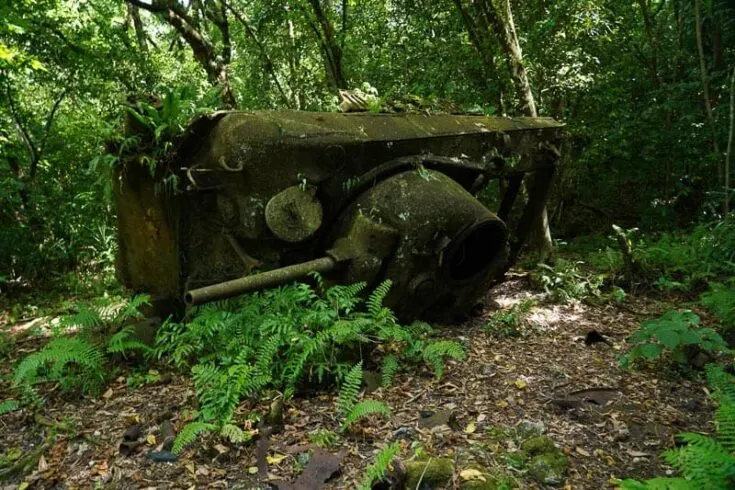
Peleliu Today
Peleliu Island Today is home to only about 700 people and one village, Klouklubed. As you can see, the Peleliu population is small.
Sometimes it can take hours between each local person you see here and days between each tourist you see; it literally seems like there’s nothing to do here except relax, read a book and enjoy a cold drink.
So, where is Peleliu island located? Peleliu is an island of Palau, near the Philippines.
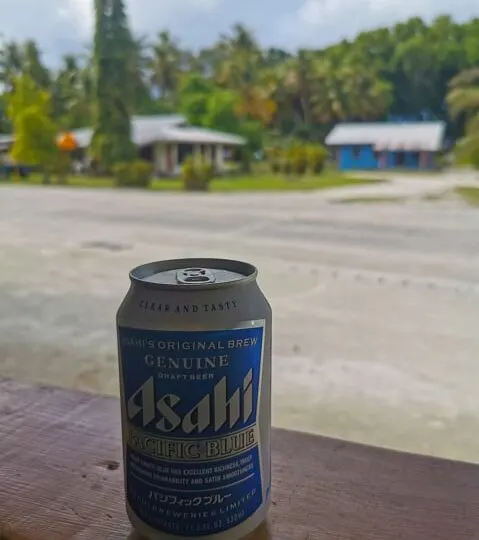
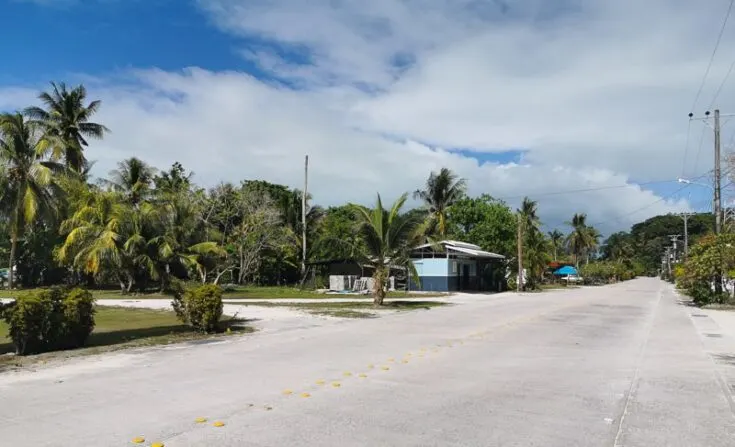
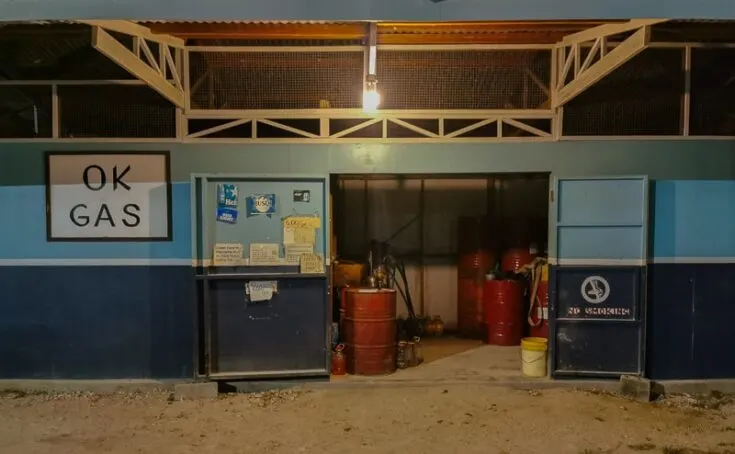
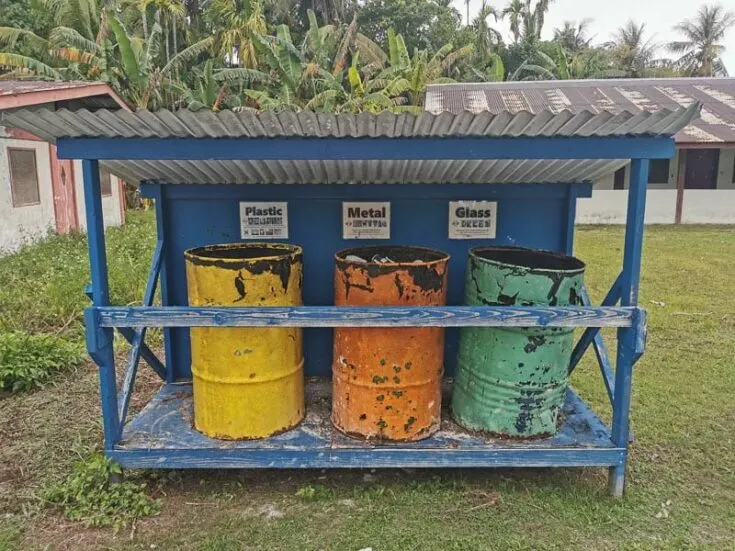
Many ask, can you visit Peleliu, the answer is yes.
But Peleliu has a dark secret if you look closer, it was home to one of the bloodiest battles in WW2, and the scars, as well as the US and Japanese war relics, are scattered all over the tiny Island.
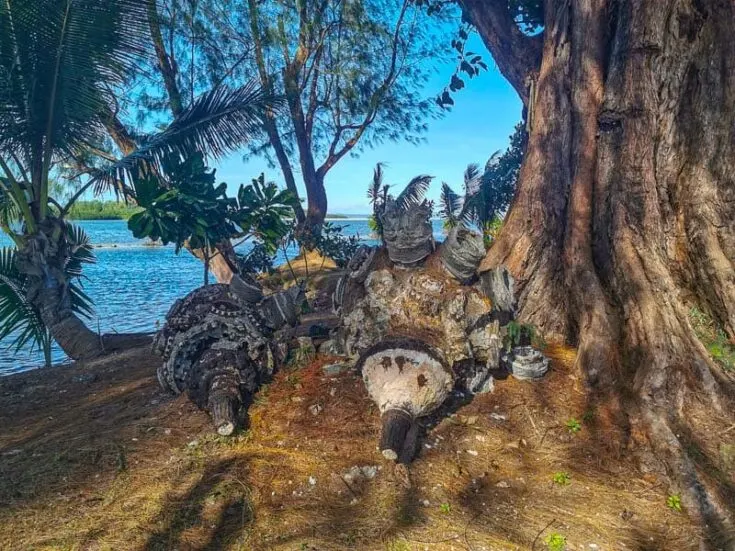
But if you look closer, will you find WW2 relics and scars scattered all over the Island, some of which are easily visible while some relics are hard to find since these days is nature taking over, and you will walk right past some of the relics without ever noticing them.
But some of the historical war relics are “already” rusting away and will not be around for much longer.
Nature is removing the scars from WW2 all over the Island. And the vegetation is so thick and lush in some places it’s like you’re in the middle of the Jungle, but in fact, are you on the highway.
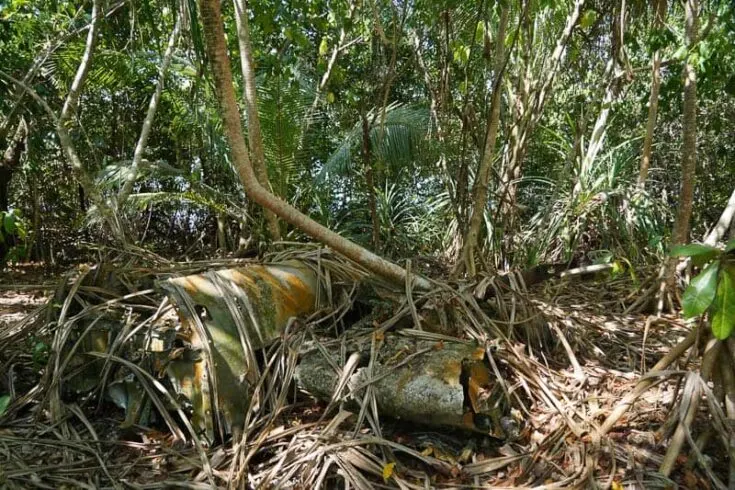
You will also be able to visit one of the many hundred caves mostly around Bloody Nose Ridge that the Japanese dog it by hand in the hills around Peleliu; the biggest man-made cave here was home to a few thousand soldiers, and still are old sake bottles and personal bowls laying around in the cave, old remains from the battle of Peleliu.
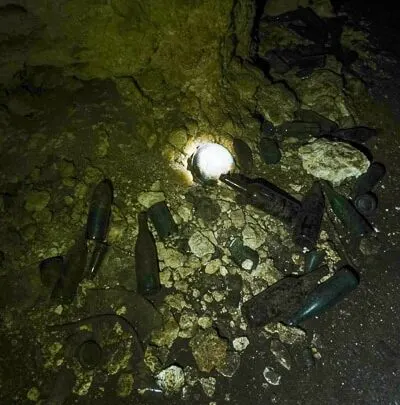
So it’s recommended to have a local guide to point them out for you and be sure to not walk too far off the trail since there’s still unexploded mines and bombs laying here but also to find some of the more hidden war relics.
Even to this day, there are new caves discovered around Bloody Nose Ridge, and only back in 2018 was a cave with the remains of 6 Japanese soldiers discovered.
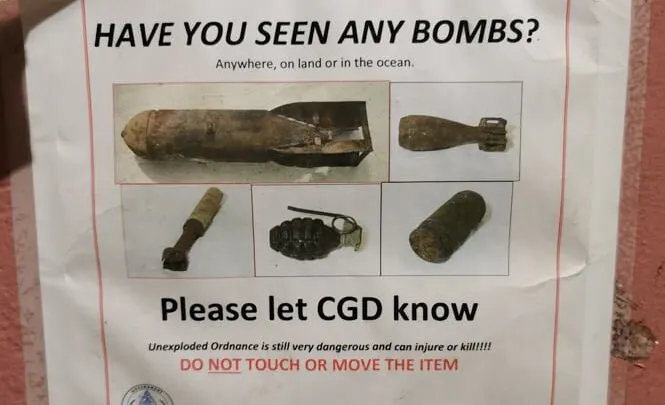
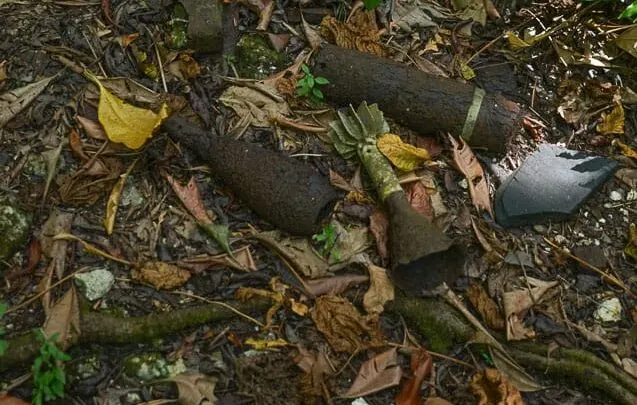
What Happened On the Island of Peleliu?
Battle of Peleliu
The American Major General in charge of the battle, William H. Rupertus, commander of the 1st Marine Division, predicted that the island would be secured within four days during Operation Stalemate 2; he couldn’t be more wrong.
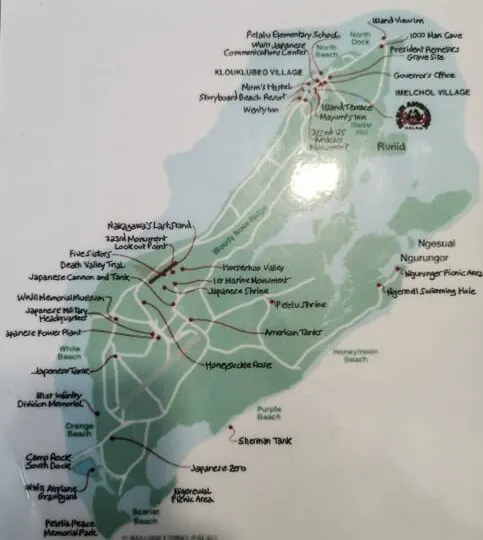
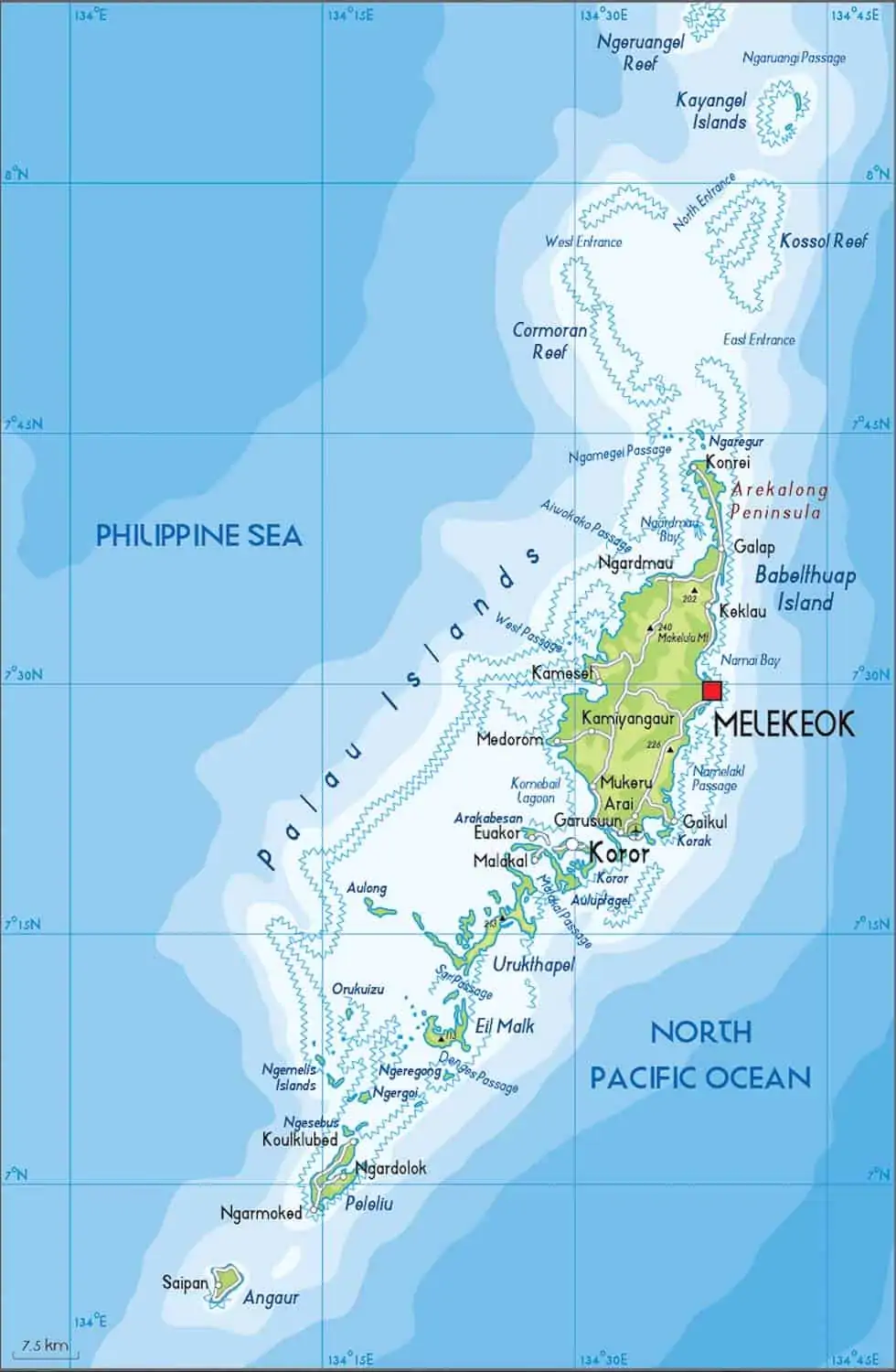
Even to this day, is the battle of Peleliu is considered to be one of the “the bitterest and bloodiest battles of the war for the USA Marines.
The entire Island of Peleliu has been listed on the National Register of Historic Places in the USA and the Peleliu Battlefield and has been designated a U.S. National Historic Landmark.
On the early morning of 15 September in 1944 did the 1st Marine Division landed on the southwest corner of Peleliu, more precisely on Orange Beach, but only after the U.S navy had bombed the hell out of Peleliu for 10 full days with airstrikes, followed by two days of Naval bombardments.
But then the third day was cancelled as the Navy declared they had already killed all the Japanese forces on the Peleliu.
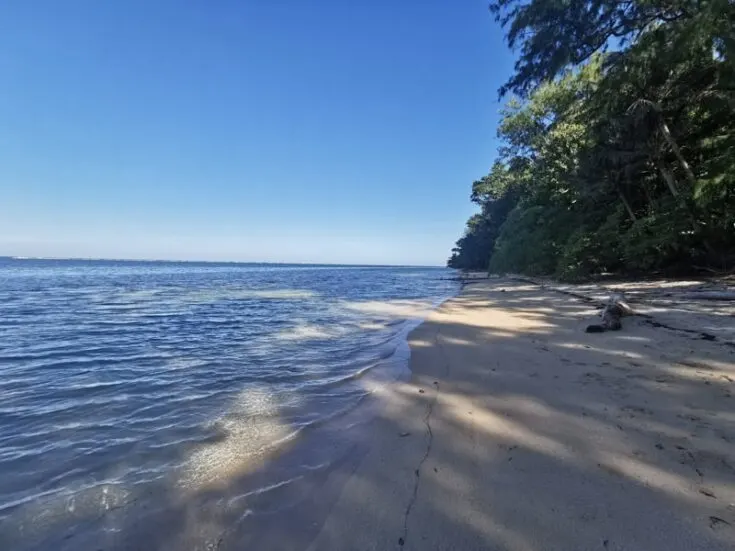
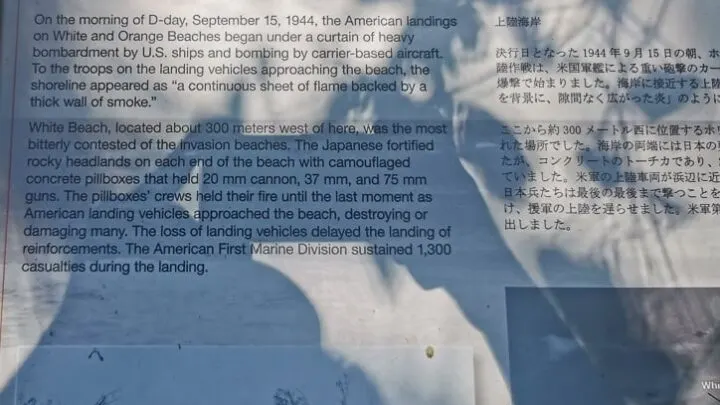
So the Navy decided it was time to invade Peleliu with the same tactic, which had proven to be successful in previous battles against the Japanese forces around the Pacific ocean.
The American troops would arrive on shore in waves, gathering on an island’s beaches until they had sufficient numbers to push inland.
These methods had worked in earlier landings for the US Navy and were expected to work again on Peleliu.
Which was a huge mistake by the U.S Navy since the Japanese Imperial forces had learned from past attacks; however, and they took a new strategy instead of fighting the Americans had the Japanese army honeycombed the hills on Peleliu with hundreds if not thousands of caves, tunnels, sniper nets, and hideouts.
And with most of the vegetation burned down all over the Island after the heavy U.S bombardment. There were nowhere to hide and nowhere to take cover for the advancing American troops.
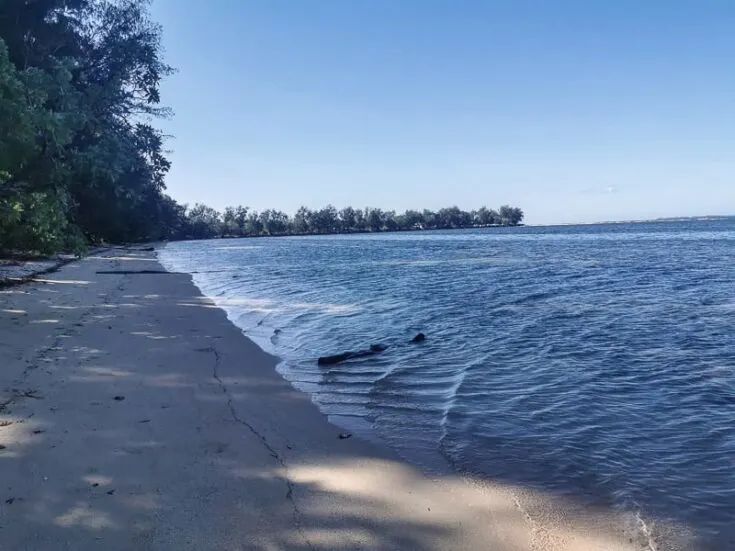
The new strategy allowed the Japanese to hunker down and hide and emerge mostly unscathed from the 13day long American bombardment of Peleliu.
The Japanese forced held out for four days before U.S. forces were even able to secure the southwest area of Peleliu, including the largest Japanese airstrip in the pacific.
But it wasn’t before the U.S forces turned north towards the small Ridge which runs through the middle of Peleliu, locally known as the Umurbrogol Mountain 91m/300feet but the U.S Marines dubbed “Bloody Nose Ridge.”
Over the next eight days, U.S. troops sustained about 50 percent casualties.
And it wasn’t before the U.S Navy bought in flamethrowers mounted on their Sherman tanks and started to burn out the Japanese from their caves that the Americans got the advantage since normal artillery didn’t do much damage to the caves.
In the end, the Japanese fought to the very end. Of the almost 11,000 Japanese troops that fought here, only 202 Survived.
In a stunning twist, a group of 35 Japanese soldiers survived within the caves of Peleliu, hiding out for an incredible 18 months after the war ended before finally surrendering in April 1947.
The Aftermath after the battle of Peleliu
The Battle of Peleliu resulted in the highest casualty rate of any amphibious assault in American military history: Of the approximately 28,000 Marines and infantry troops involved, an insane 40 percent of the Marines and soldiers that fought for the Island died or were wounded, for a total of some 9,800 men (1,800 killed in action and 8,000 wounded).
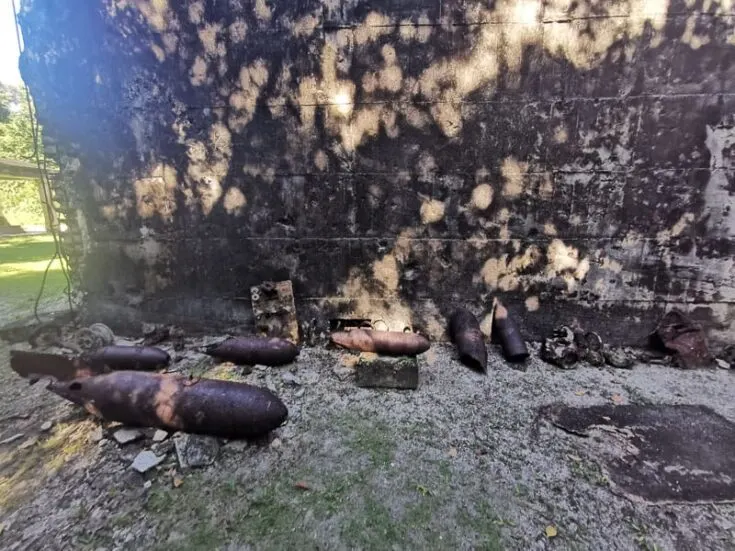
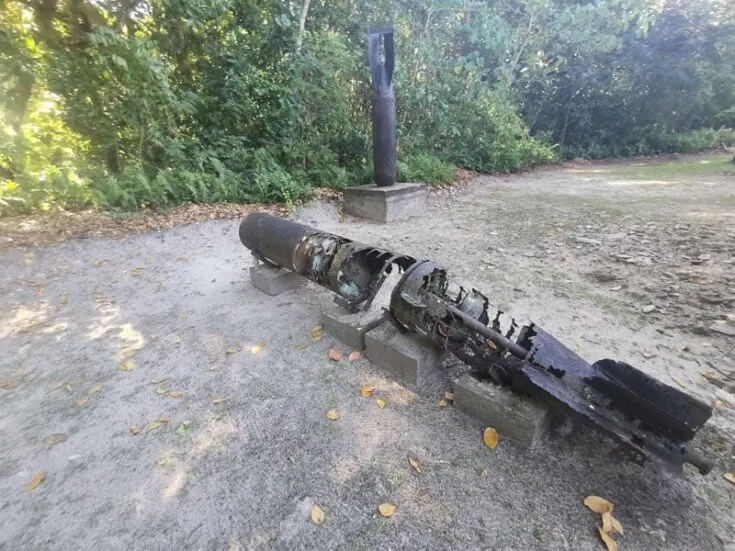
The high cost of the battle was later blamed on several factors, a typical U.S Navy overconfidence in the efficacy of the pre-landing naval bombardment, a poor understanding of Peleliu’s unique terrain, and overconfidence on the part of Marine commanders, who refused to admit their need for support.
Postwar statisticians calculated that it took US forces over 1500 rounds of ammunition to kill each Japanese soldier and that during the battle.
The Americans used 13.32 million rounds of 30-calibre, 1.52 million rounds of 45-caliber, 693,657 rounds of 50-caliber bullets, 118,262 hand grenades, and approximately 150,000 mortar shells.
This is additional to the 10 days pre-bombardment with airstrikes and 2 days of Naval Bombardment.
Bloody Nose Ridge Today
Bloody Nose Ridge was the most of the battle happened, with the Japanese soldiers hiding inside one of the 400 caves they had dug out by hand here.
These days there are also a few hiking trails you can do around the Ridge, but be sure to keep on the marked trail since there can still be unexploded bombs lying around.
While there are still a few caves you can visit, you can also see the command post used by Kunio Nakagawa, commander of Japanese forces here on Peleliu.
At the end of the battle, on the evening of 24 November, Nakagawa performed seppuku (ritual suicide) in the tradition of Japanese samurai warriors.
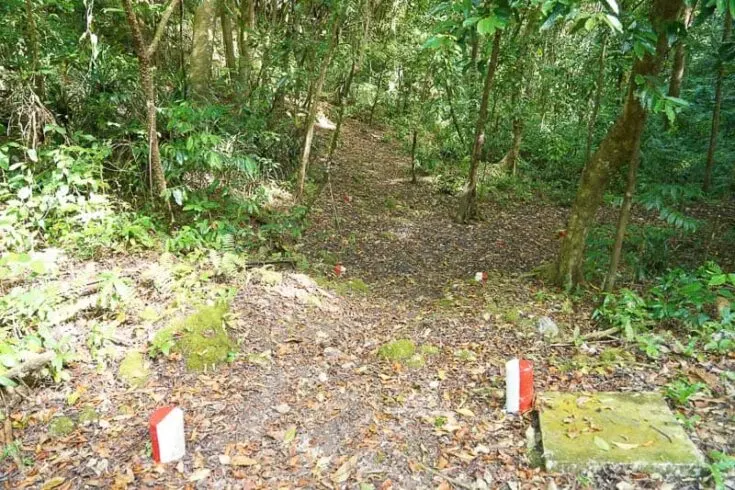
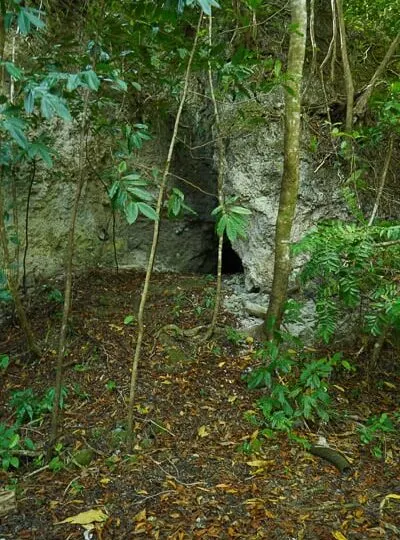
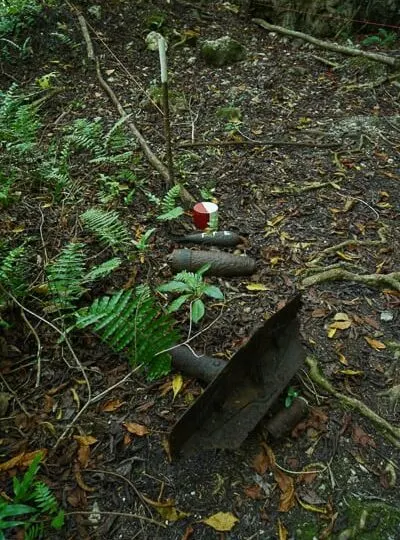
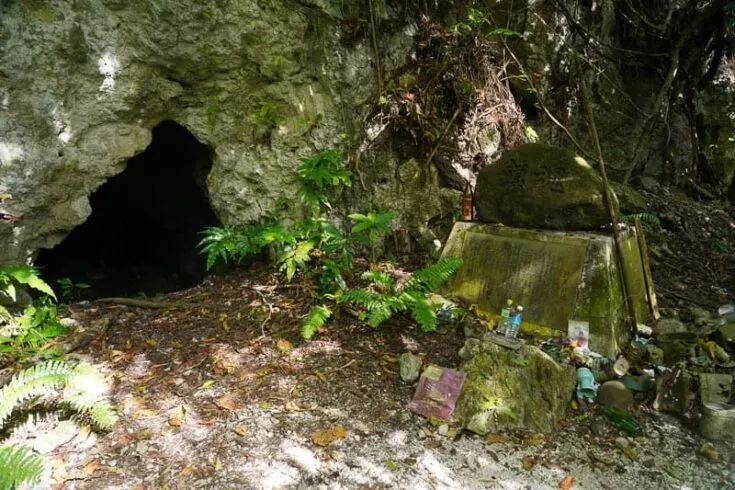
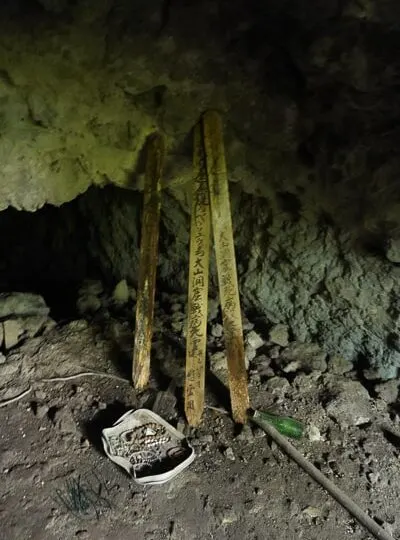
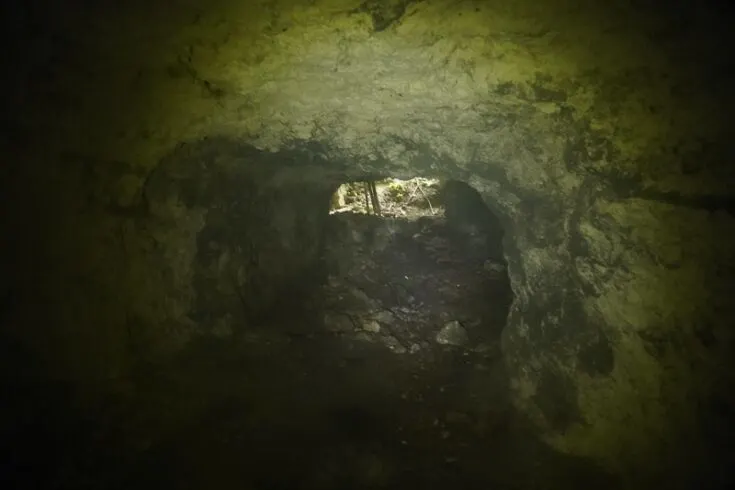
The 1,000 Man Cave – Peleliu Caves
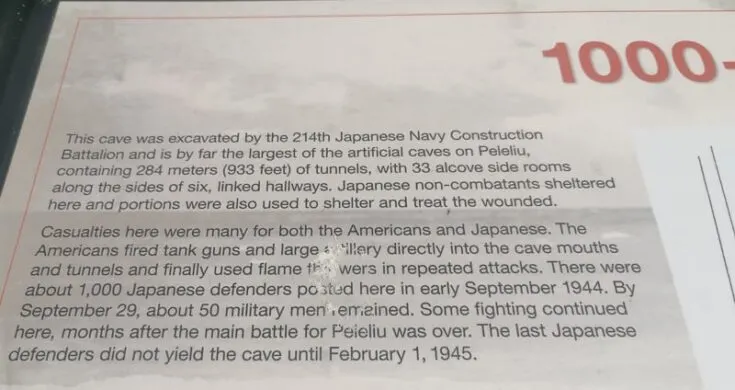
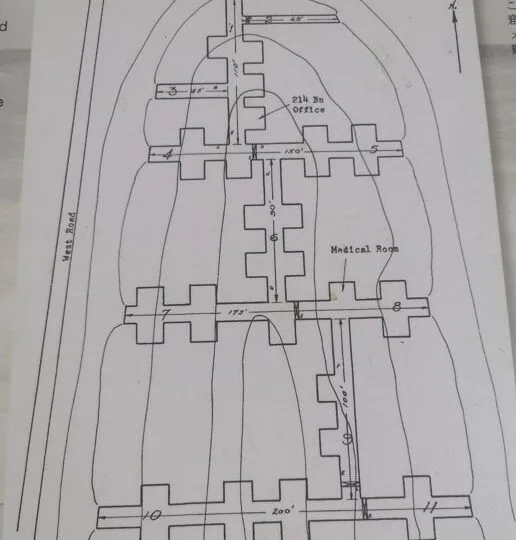
The most famous cave, which is not on Bloody Nose Ridge, is the 1,000 man cave which is located close to the harbor.
This cave is by far the largest man-made cave on Peleliu. The 1000 man cave holds an impressive 284 meter (933 feet) of tunnels, containing 34 rooms, including a small hospital and a Shrine. The cave was home to 1,000 Japanese soldiers, which is where it got its name from.
The 1,000 Japanese soldiers hiding in this cave refused to surrender.
The US Marines – they resorted to blocking up the exits, leaving only two open, and using flame-throwers and explosive charges to force the remaining Japanese out.
While walking around the cave, you can see that the roof inside the cave is still black after the flamethrowers.
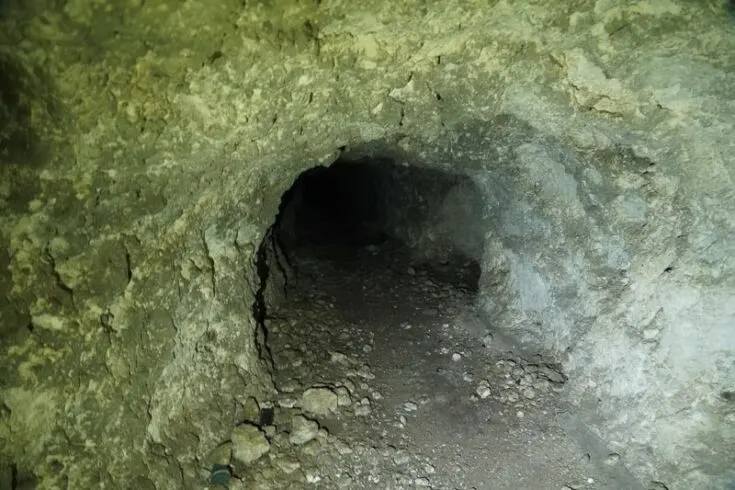
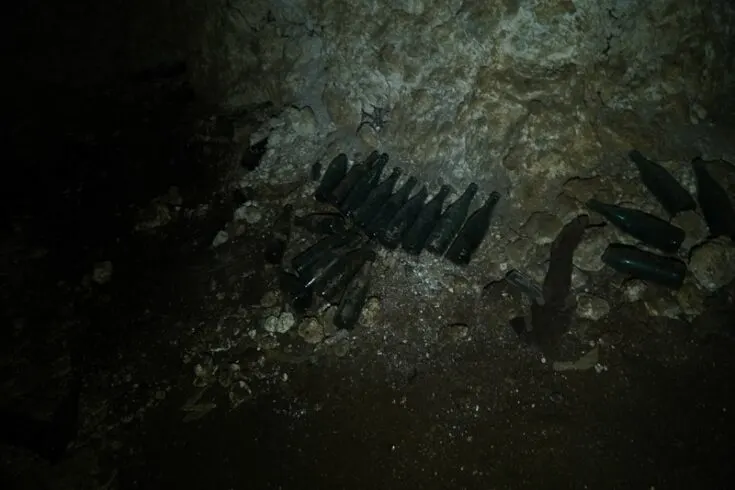
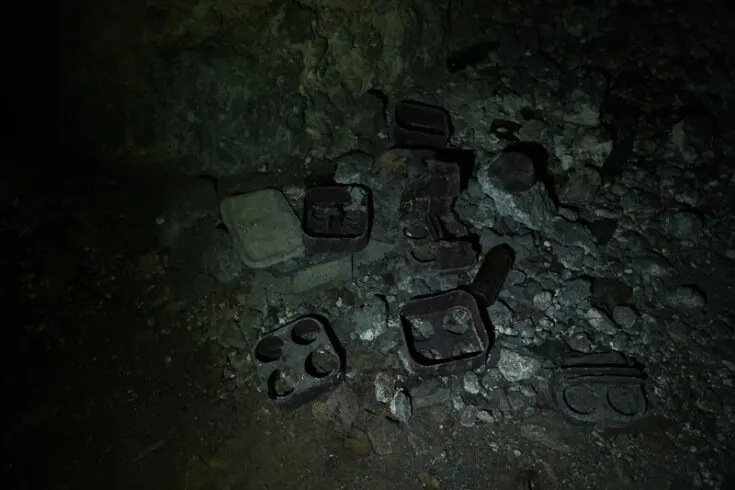
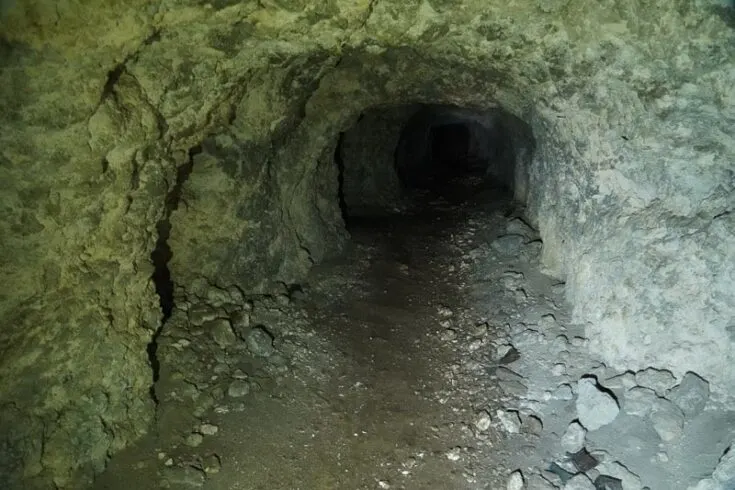
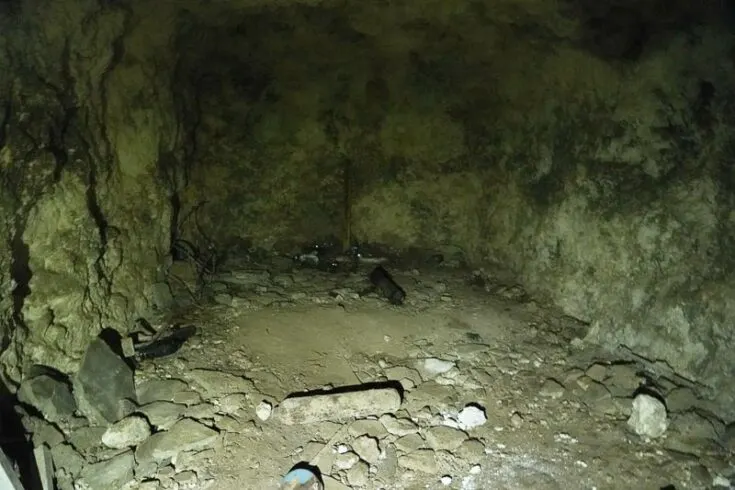
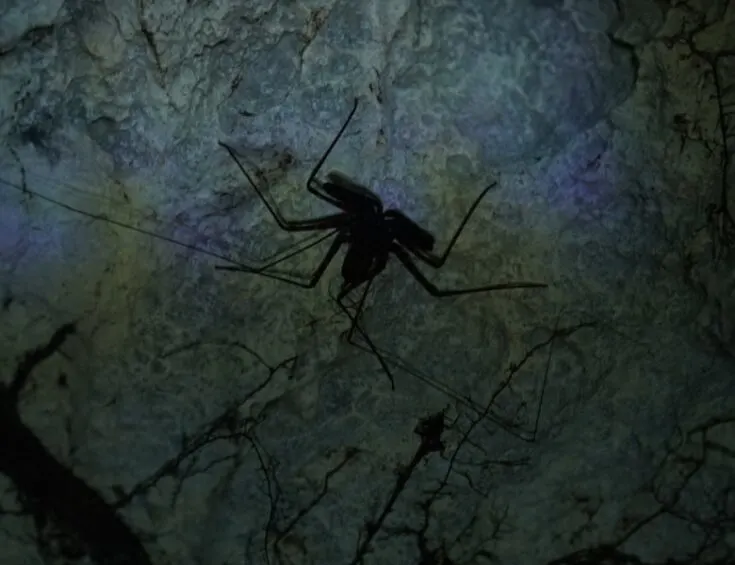
War Relics That You can see Around Peleliu
Japanese Full Storage Building, now the WW2 Museum in Palau the museums holds photographs and war artefacts, including weapons and uniforms.
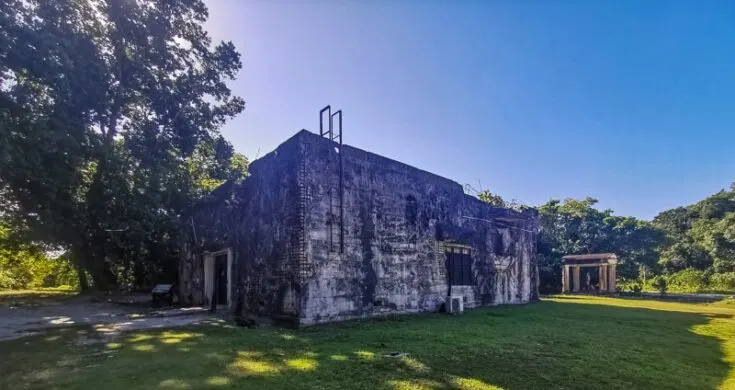
Japanse Mitsubishi Zero Fighter Plane.
The remains of a Japanese Mitsubishi Zero Fighter yet, located just of the main road, but it is easy to miss it if you don’t know where to look.
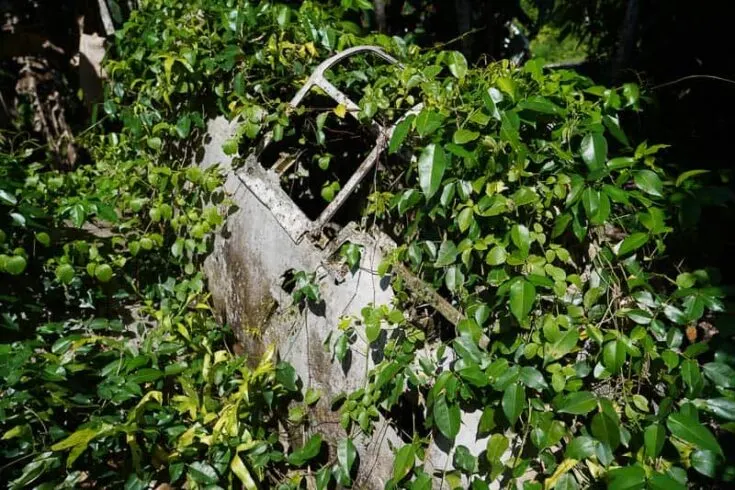
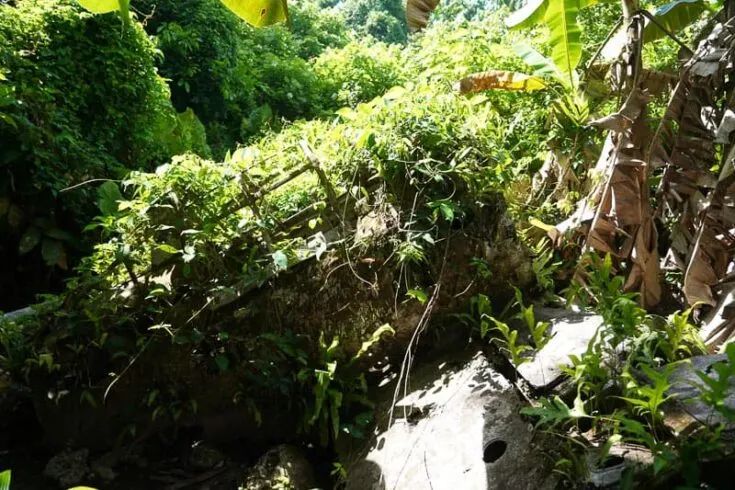
A Japanese tank that was used to protect the airfield.
Located just on the outskirts of the old Peleliu Airfield is an old destroyed Japanese tank, which surely has seen better days.
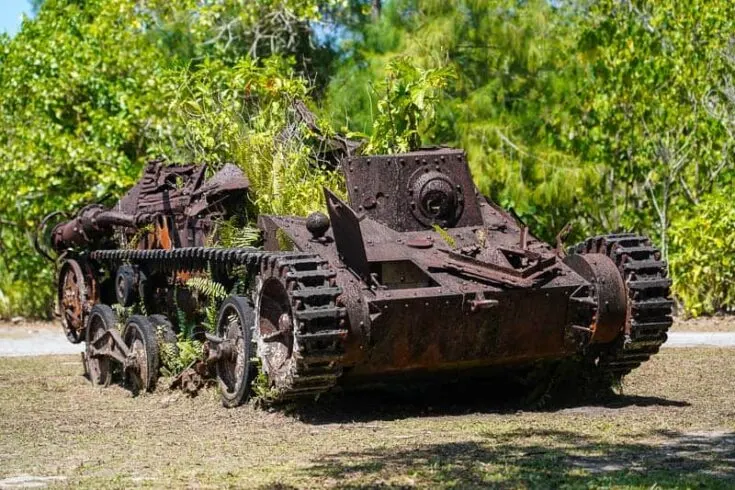
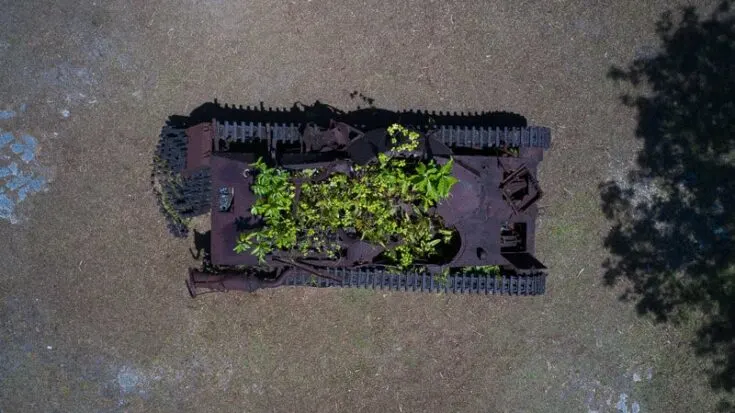
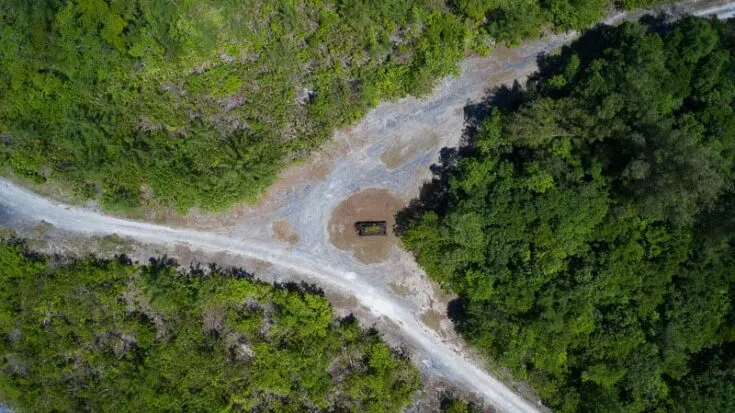
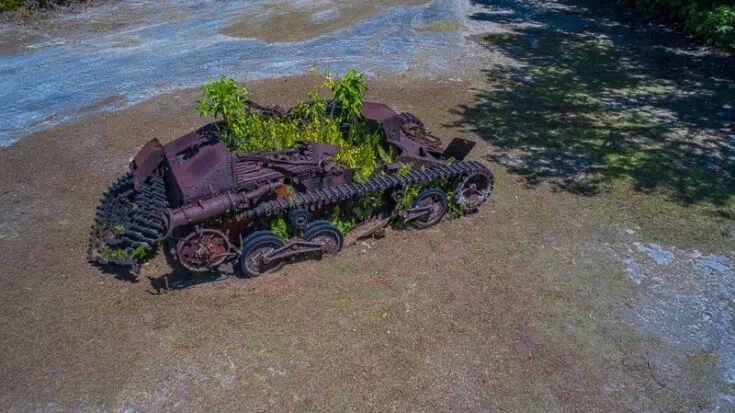
The Old Japanese Headquarters
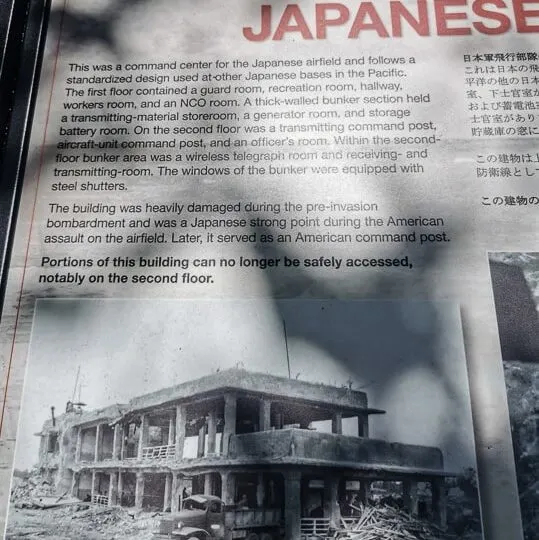
In the middle of the Jungle is a two-story building which was the Japanese headquarter here during WWII. It was important in their efforts to control Peleliu and was very fiercely defended, but the Americans managed to bomb it in 1944.
With stairs going nowhere, threes growing through ceilings, and exposed wires and girders forming uncanny shadows on the green.
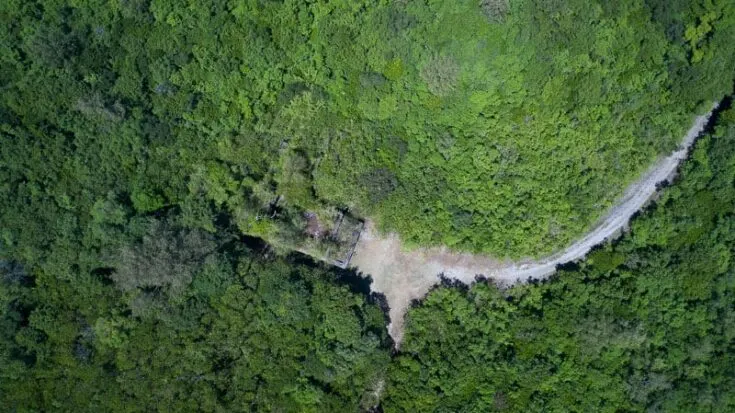
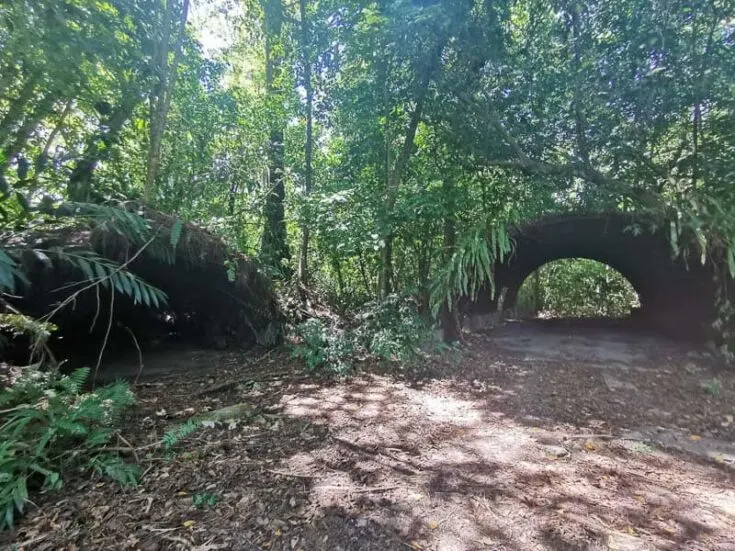
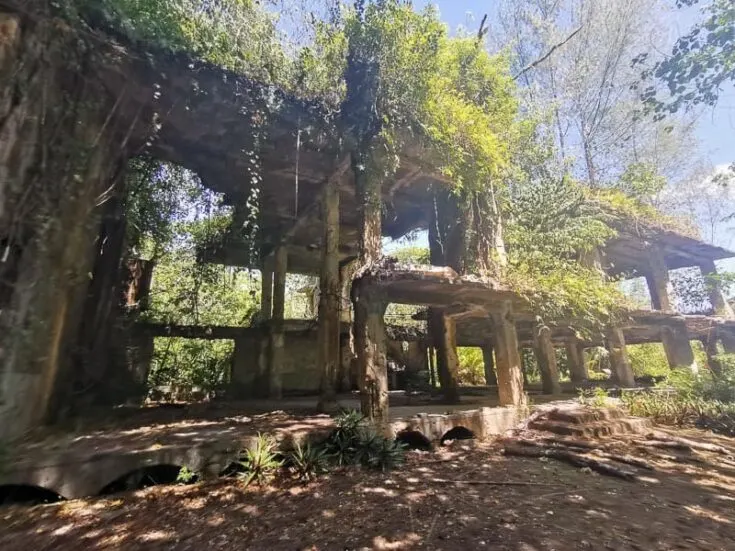
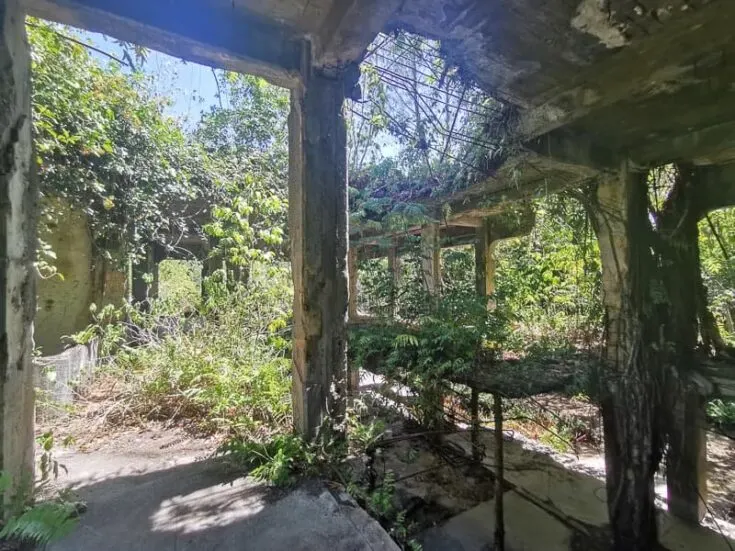
Peleliu Airfield
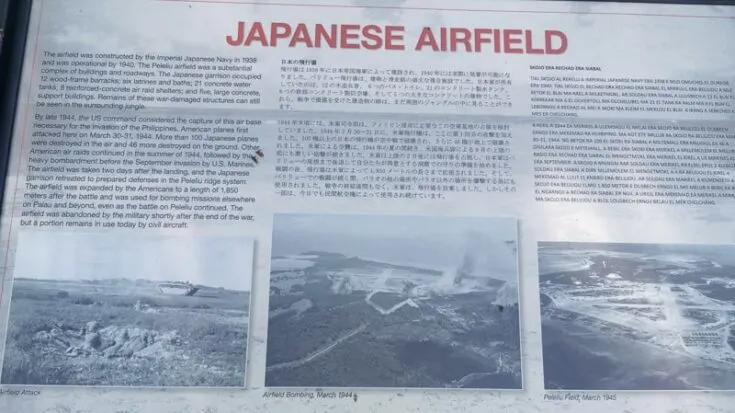
Peleliu Airfield today
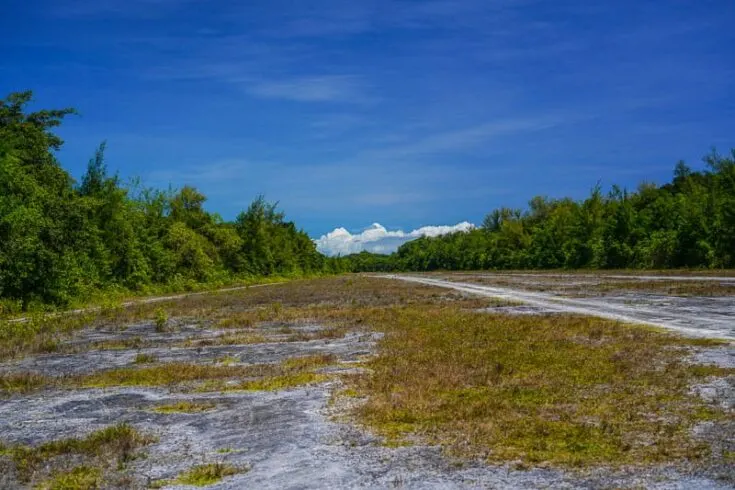
American Tanks
Northwest of the airstrip are two old rusty American tanks parked up. Both are LVTs – Landing Vehicle Tractors – that were used to carry US Marines from ship to shore when the US invasion forces landed on Peleliu.
One of them has a 75mm gun. There are a few grenades laying around here.
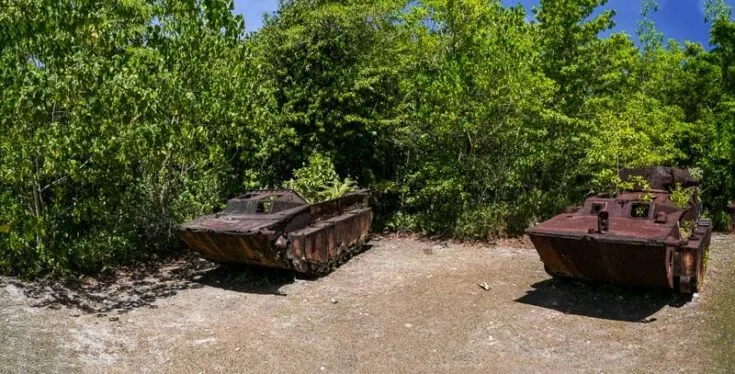
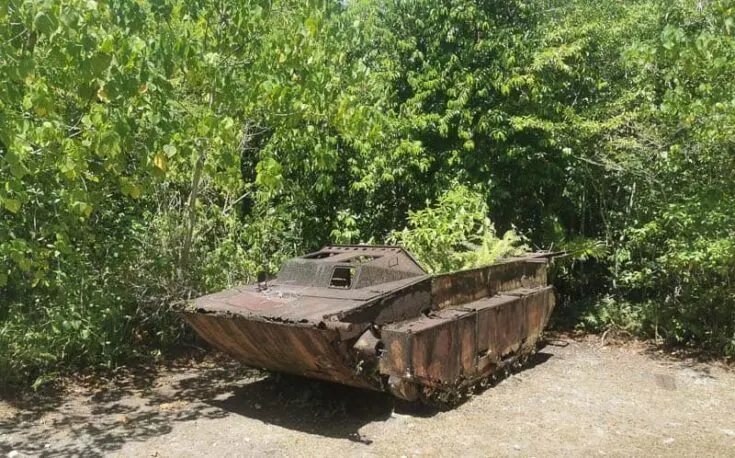
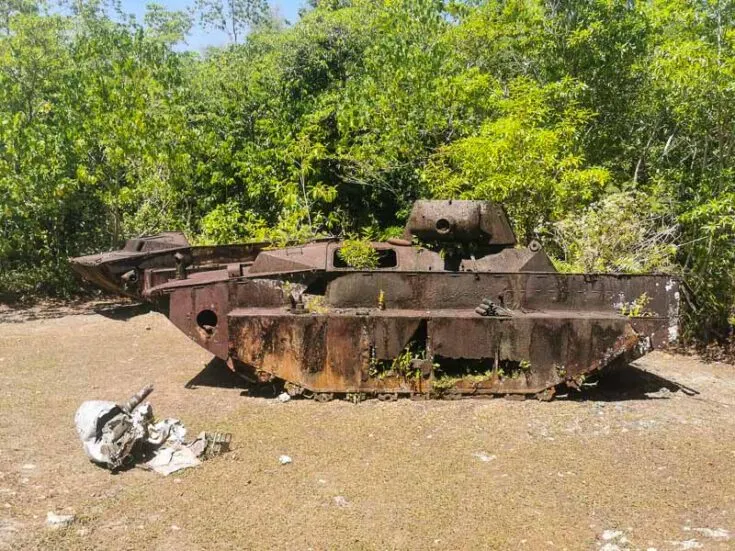
Japanese Tank and Anti Aircraft Gun
In a small man-made cave is the last of 4 Original Japanese 200mm coastal defence guns.
Such caves allowed the Japanese to safely pick off Marines exposed on Orange Beach.
The 3 other coastal defence guns were dismantled by Americans.
There’s an old rusted up LVT A1 just outside the cave.
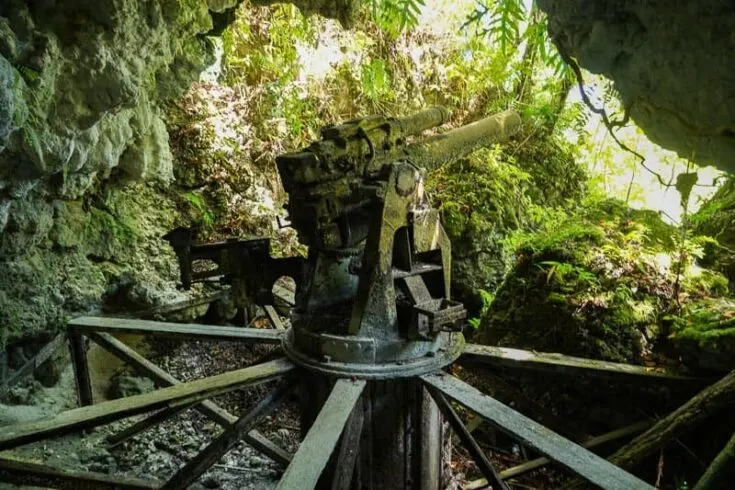
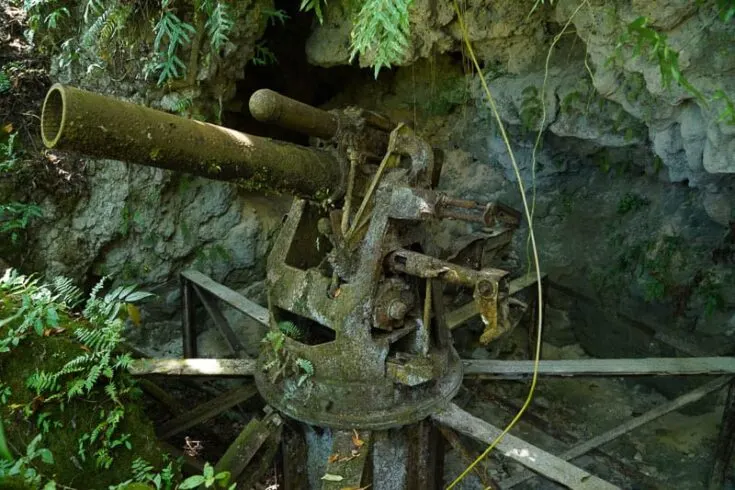
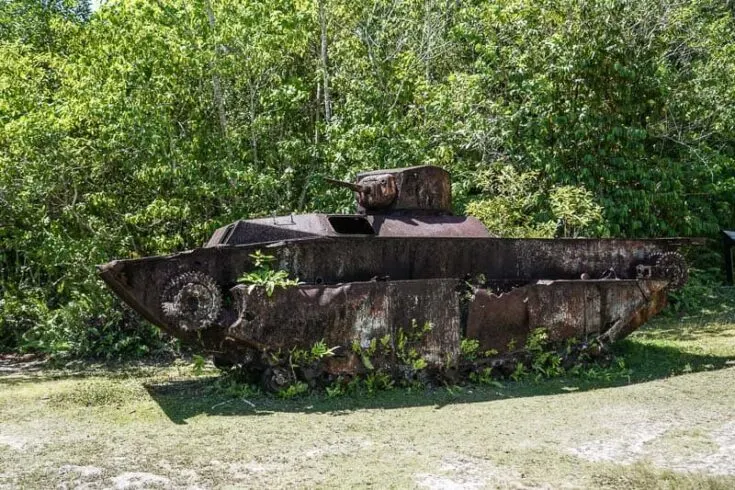
Knocked Over American Sherman Tank
Seeing this tank all overgrown is an important part of Peleliu travel as it depicts the devastation that took place on the island during WWII.
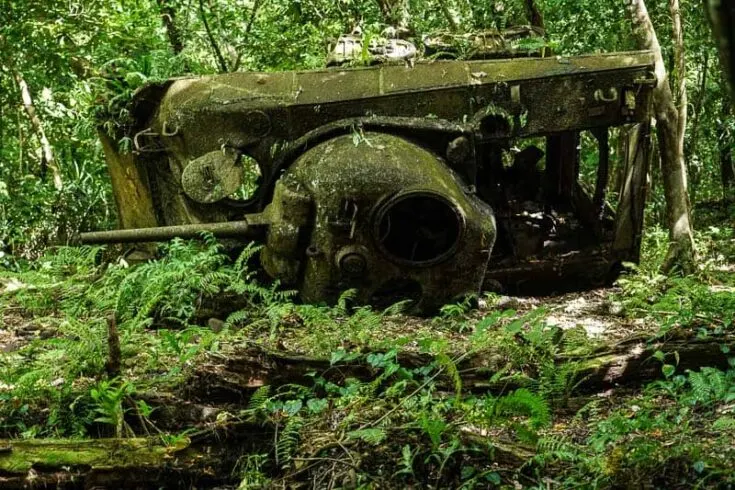
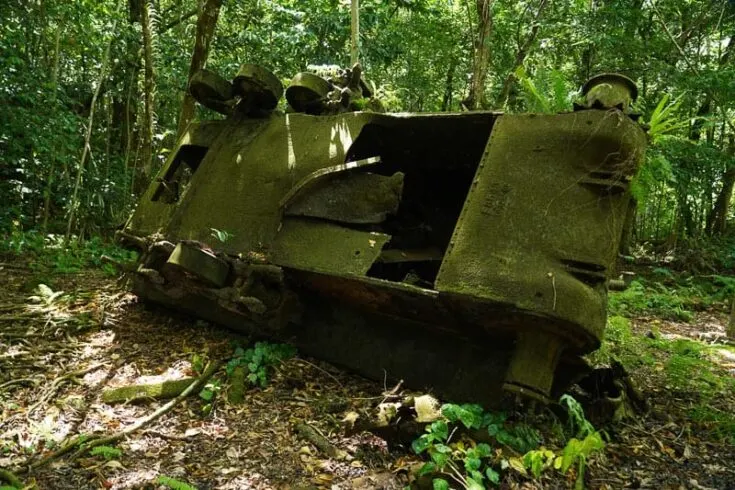
Memorials and Shrines on Peleliu
With so many Soldiers dying here during both Americans and Japanese, so are a few memorials and shrines to remember the fallen here.
On the far southern tip of Peleliu is the Peleliu Peace Memorial Park, a park the Japanese government built in 1985 for those who died here during WW2. It’s from here that you can see across to Angaur island.
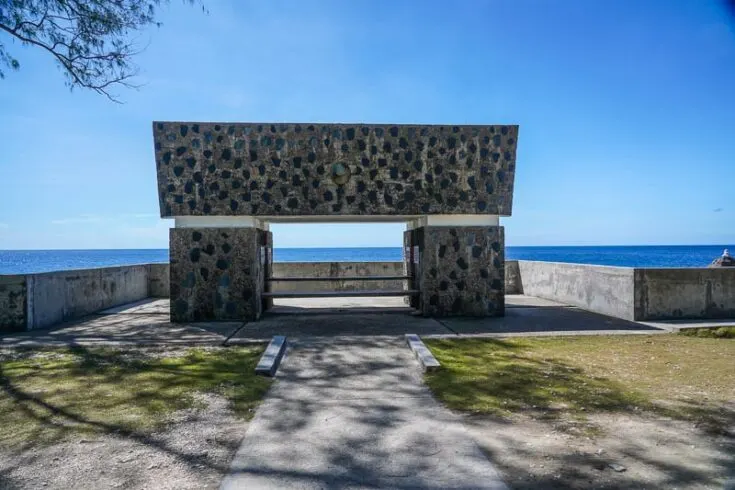
At the base of Bloody Nose Ridge is this small shrine commemorating the Japanese soldiers who died in the WWII Battle of Peleliu.
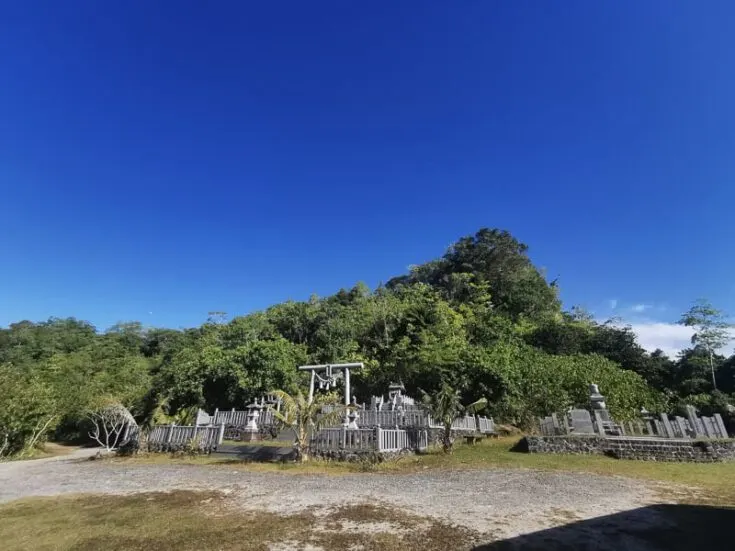
US Marine Corps Monument on Peleliu
Just across the Japanese shrine on the base of Bloody Nose Ridge is the US Marine Corps Monument dedicated to the US Navy and Marine Corps troops who died here in 1944.
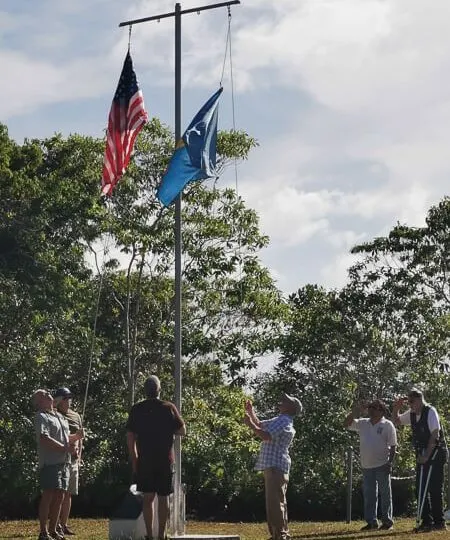
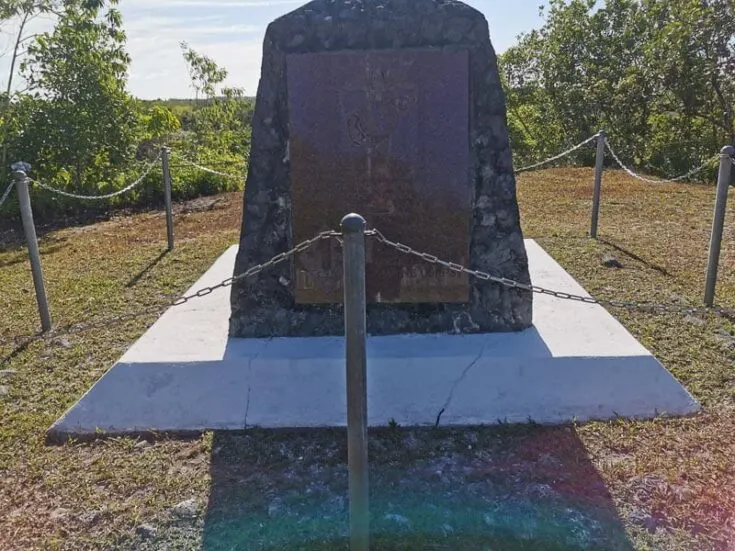
One of the highest points on Peleliu is the US Army 323rd Infantry Monument & Lookout. There are 100 steps to get to the lookout from where you can see a 360* view of the Island.
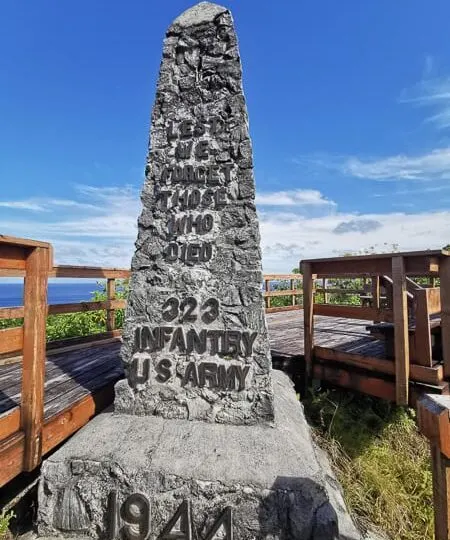
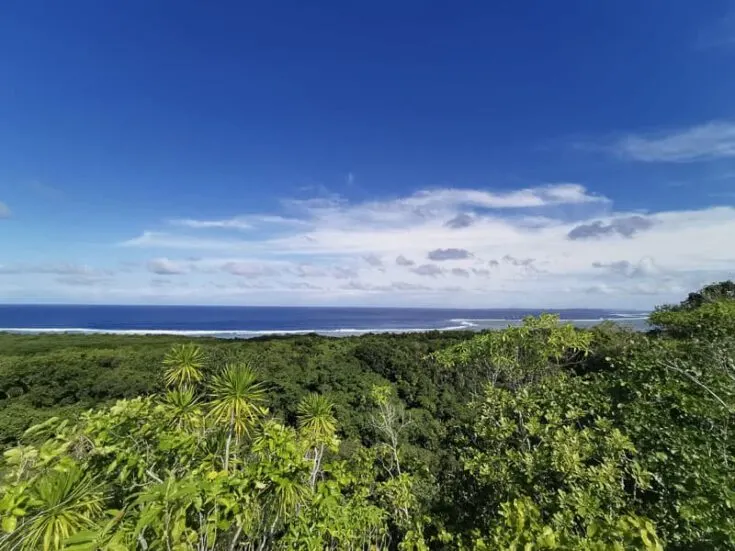
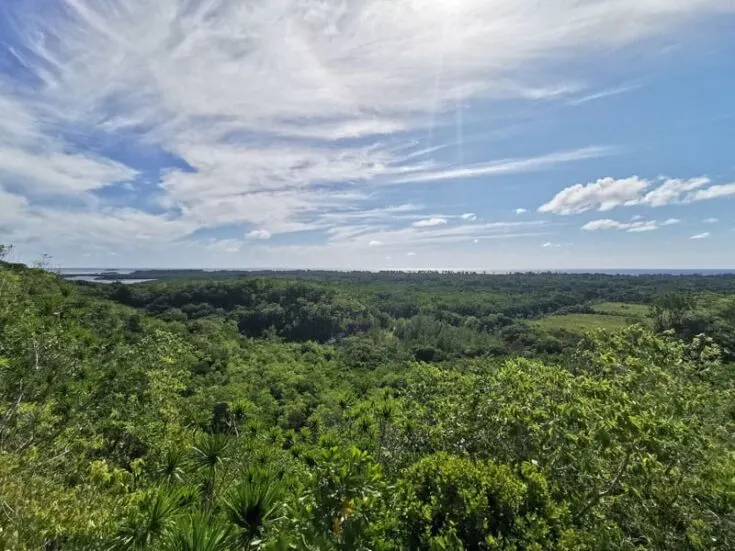
Other Things To Do When You Visit Peleliu island
The main reason foreigners visit Peleliu is for relics from WW2. However, there are a few other things to do on the Island. But remember everything requires a permit (entrance ticket) similar to on Koror and the Rock Islands.
Scuba Diving Peleliu island
Some of the best Scuba diving in Palau is just a few minutes boat ride from Peleliu, while the same dive sites take more than an hour to reach from Koror.
Snorkeling is also a great activity to do on Peleliu, with snorkeling sites being more accessible here than around Koror.
Beach
There are surprisingly few good beaches around the Island, but the good ones are great, but be aware that’s no facility on any of the beaches, so you will have to carry any snack or drinks you will need.
And be aware that there are no shops outside Klouklubed, so stock up before heading to the beach.
If you want a beach with history, so are Orange and White beach to good beaches, but the best beach on Peleliu is on the way to the Japanese Memorial on the Southern tip of the Island.
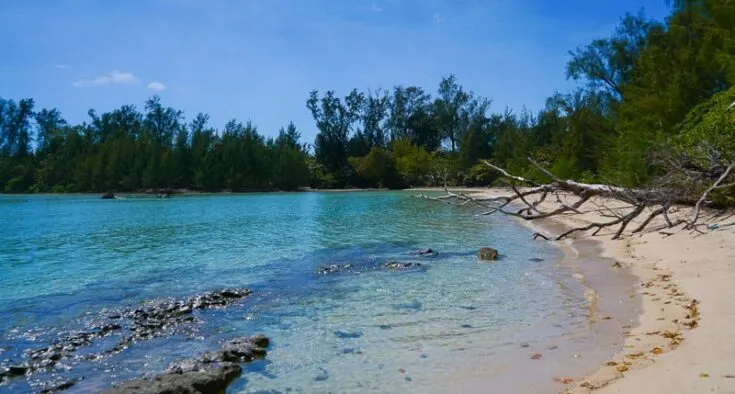
This beach is located inside a calm lagoon, and the water is always calm here, making it a great place for swimming. Other parts of Peleliu have strong currents and big waves.
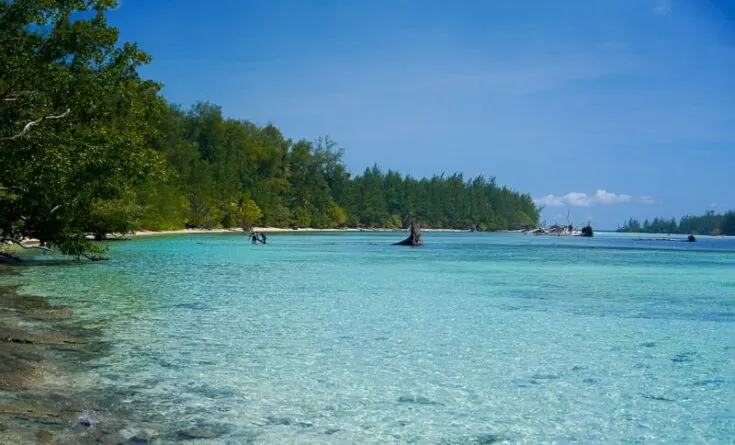
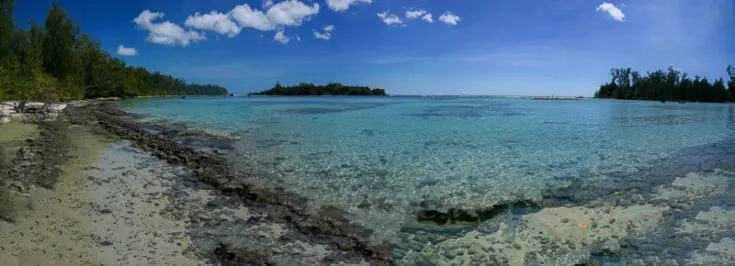
Birdwatching
Palau is becoming a popular destination for birdwatchers from all over the world, and from a study done by the Palau Conservation Society.
It is the Island of Peleliu which has the highest bird population in Palau
Fishing
The waters around Peleliu are popular with tourists wanting to go deep-sea fishing and trolling or if you want to go spearfishing.
Remember you will have to go with a licensed boat.
There’s also popular to go looking and hunting for crabs around the mangroves or for coconut crabs.
Visiting Angaur Island
Angaur island is another inhabited island in Palau and the only Island on the south pacific Island with Monkeys. After visiting Peleliu, Angaur Island is the next logical step. Angaur was also home to a WW2 battle between Japan and the US. But far from as bloody as on Peleliu.
Angaur is located only about 5miles/8Km south of Peleliu. You can see Angaur from the southern tip of Peleliu. But so close but still so far away.
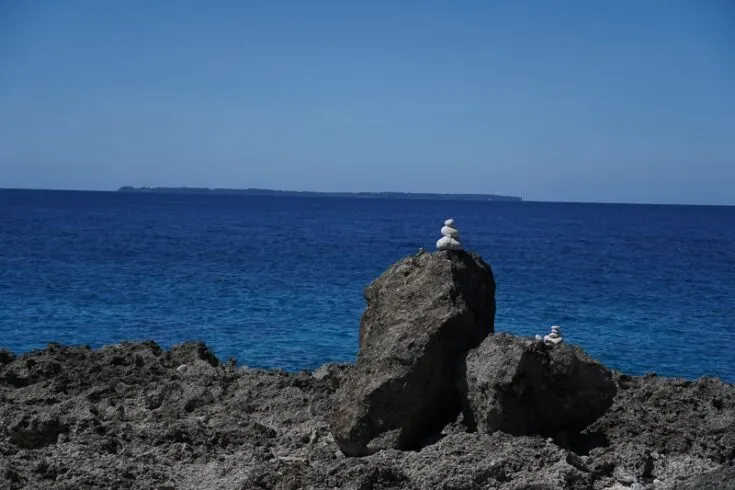
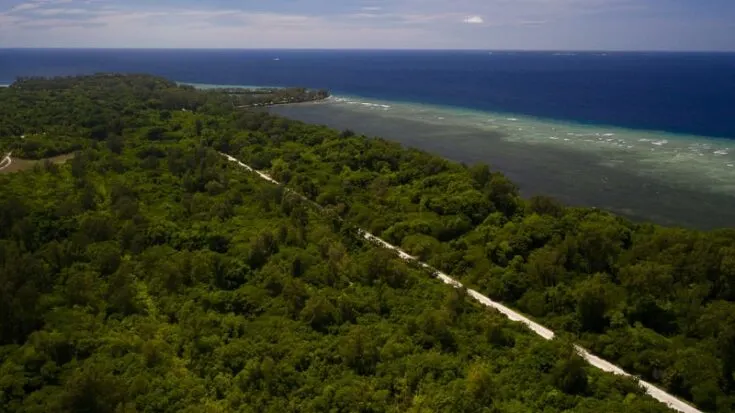
I tried to get to Angaur for days, but the waters around Angaur are notorious for extremely strong currents and waves, so no boatmen wanted to take me there. I asked all over the Island, and it seemed impossible.
Even the local travel agency which offers day trips there refused.
So the only way to reach Angaur is with a small local flight, either on one of the twice-a-week scheduled flights or on a chartered one.
Accommodation on Peleliu Island
These days accommodation options on Peleliu are pretty limited. According to online research, there should be four different accommodation options on the Island, but when I arrived, 2 of them were completely shut down.
And when I asked the locals on Peleliu if it was a temporary shutdown or a permanent one, they had no idea.
So by early 2021, there are two options for accommodation on Peleliu.
High-End Accommodation Peleliu.
Dolphin Bay Resort & Peleliu Divers, the high-end option on Peleliu and home to the only dive center, has private bungalows which are equipped with ceiling fan and A/C and private bathroom, fridge and mini-bar, and private balcony.
They have 2 types of rooms(queen bedroom and twin bedroom). Both rooms cost US$185.00 (including10% tax) per night.
And the package rate, including meals, is US$210.00 for single occupancy and U.S $250.00 for double occupancy.
They have a great sundeck and one of only two bars on the Island. Even if you are not staying here, the sundeck is a great place to go for a cold beer and to watch the sunset.
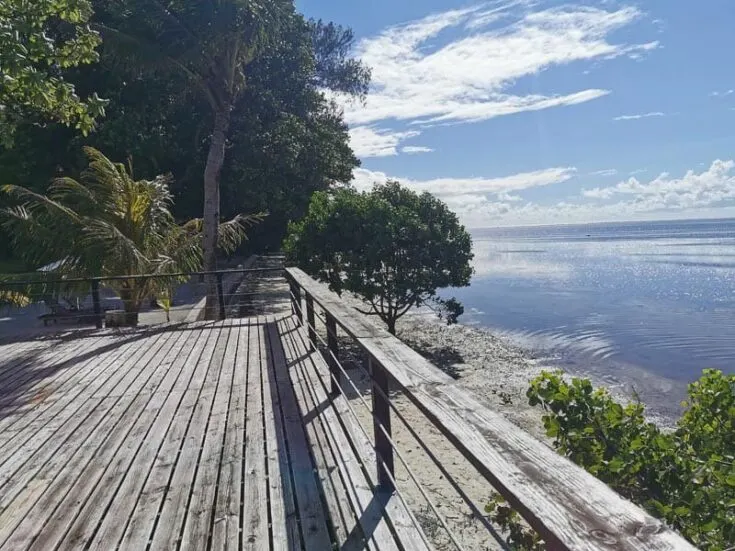
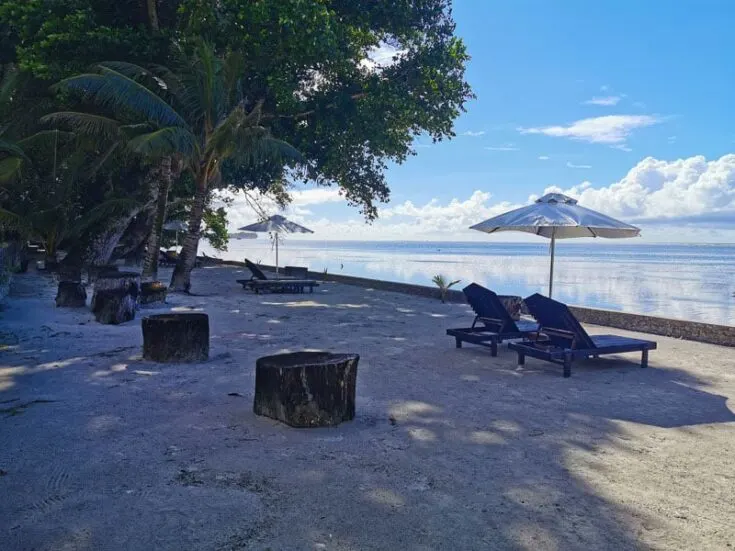
The budget accommodation Peleliu
The Adventure Inn, which is the only travel agency on the Peleliu, also has a guesthouse and a hostel with a shared bathroom and a shared kitchen and common area.
But you will get your own room with Aircon for 40USD night. I stayed here during my stay, and I will recommend it.
Where To Eat on Peleliu
Everything is very limited on Peleliu.
There are a few small shops which sell everything you will need for daily use along the main street.
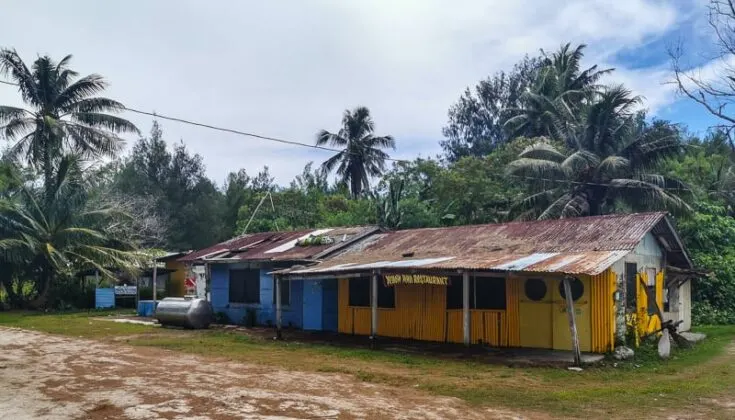
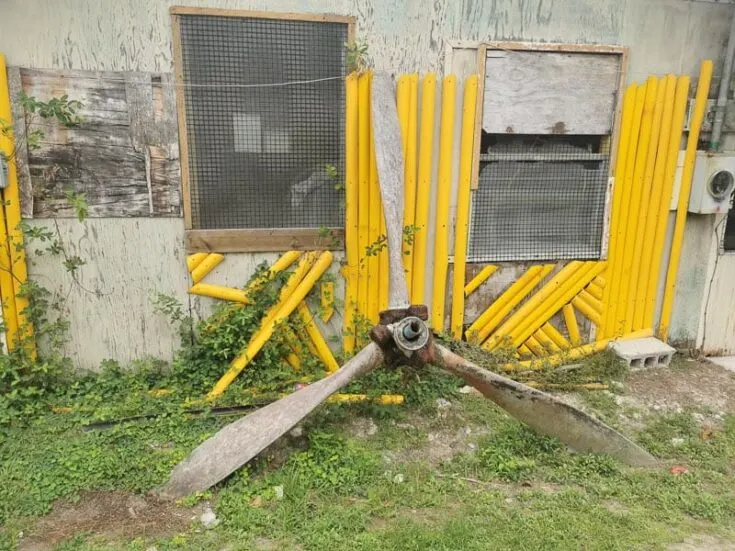
If you are staying at the hostel in the Adventure Inn, you will have a common kitchen where you can cook for yourself.
There are three restaurants on the Peleliu island, one at Dolphin Bay Resort which is also the most expensive. There’s one Chinese restaurant next to the most well-stocked bar next to the largest supermarket on Peleliu.
Adventure Inn also has a small restaurant with a set menu each evening.
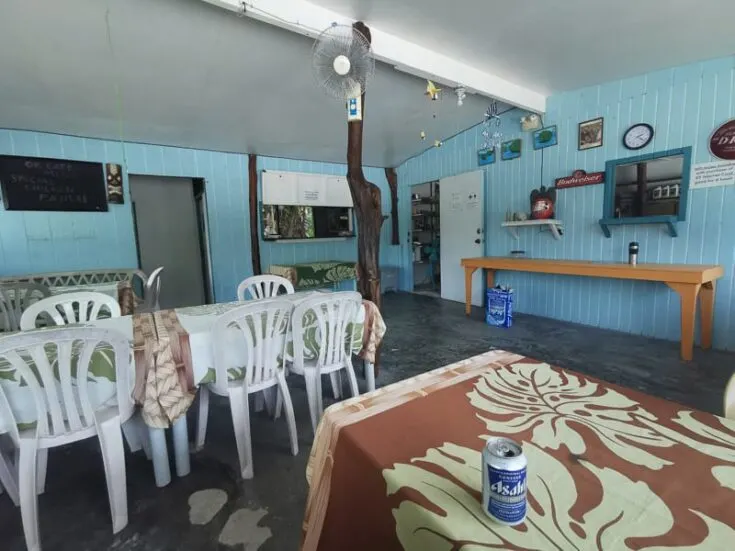
Getting Around Peleliu
There’s no public transportation around Peleliu. So you are stuck with self-driving, bike cycling around the Island or making a day trip for around 40USD with a guide which I recommend since some of the WW2 relics are almost impossible to find on your own.
You can rent a bike for 20USD from Adventure inn.
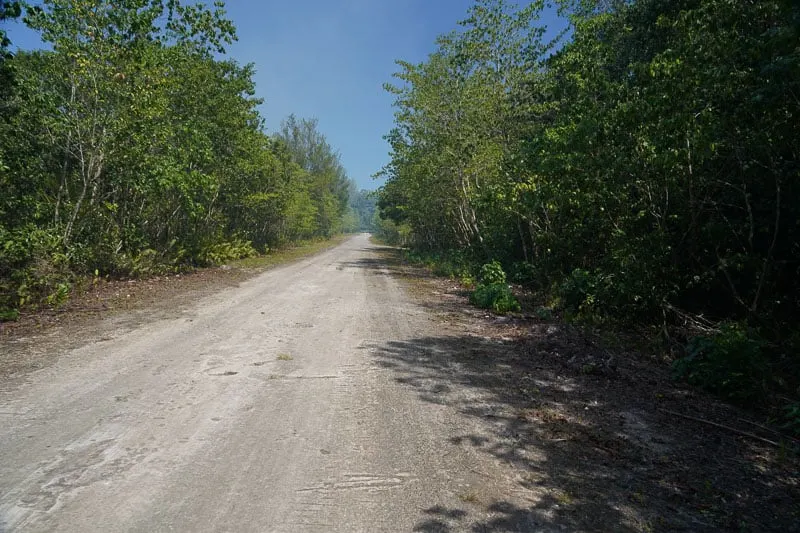

While the Island is almost completely flat, except around Bloody Nose Ridge, so is there very little shade and nowhere to buy anything to drink around the relics, so be sure to bring enough water.
How to Get To Peleliu Island With Public Ferry
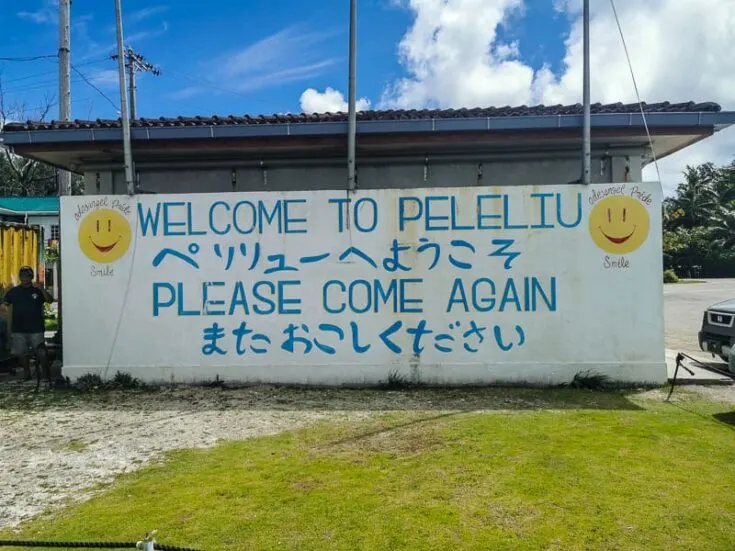
There are two government ferries between Koror and Peleliu, a fast one, the Odesangel Dill, and a slow one, the Nippon Maru II.
Both ferries are very basic, on the slow ferry are you recommended to bring your own chair! And be sure to bring snacks/drinks for the journey; there’s nothing for sale onboard.
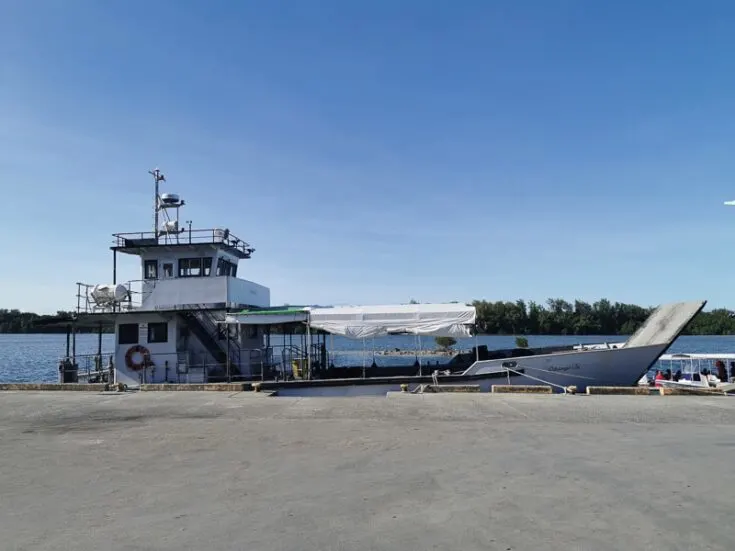
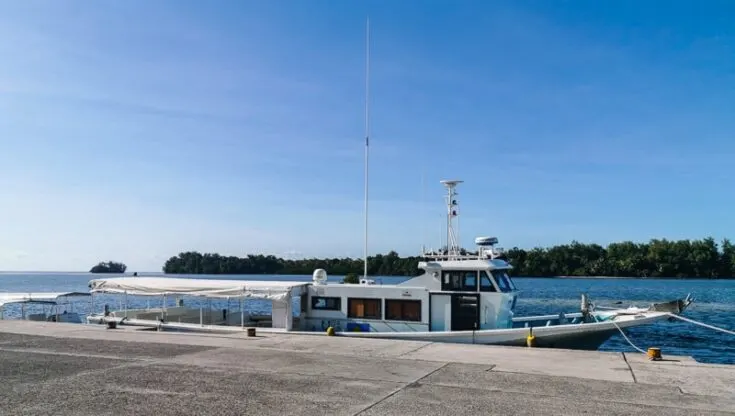
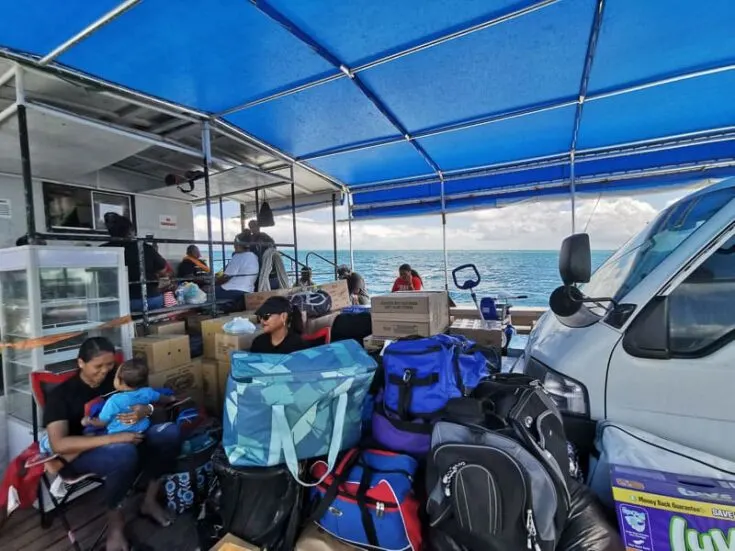
But the public ferry schedule changes every month.
The Public ferry takes about takes approximately 2 to and a half hours to 3 and a half hours depending on the weather and wind and which route it has to take around the rock islands.
When it’s windy, is it a very uncomfortable and wet trip (waves splash over the whole boat), I had it back to Peleliu.
The price is 20USD for the slow boat, and the fast boat takes 1.5hour and coast 40USD. Each boat charges a 1 USD fee for each bag.
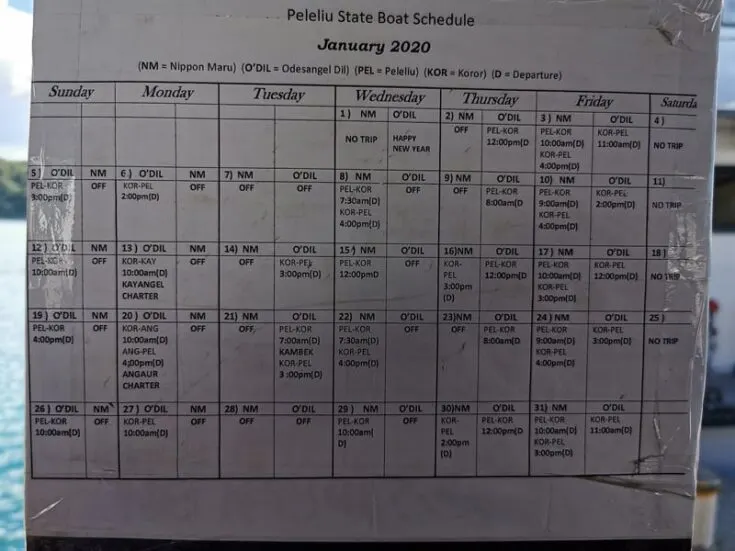
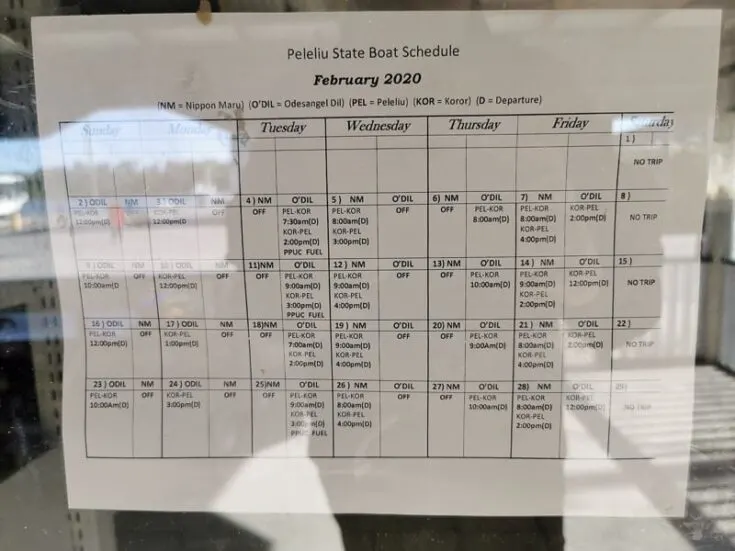
How to Get To Peleliu Island With Flight
The only airline doing scheduled inter-island flights in Palau is Pacific Mission Aviation which also does the scenic flight over the rock islands (which I will highly recommend).
They have scheduled flights on Tuesday and Saturday from Koror to Angaur and Peleliu. There are only small single propeller flights available for 5 and 9 passengers.
Tuesday: 9 am Departure at Palau International Airport. 945 am Departure from Angaur/Peleliu. Flight time one way is 30min.
Saturday: 9 am Departure at Palau International Airport. 1130 am Departure from Angaur/Peleliu. Flight time one way is 30min.
If this doesn’t fit your schedule, so is your only option to charter the flight for 400 USD for up to 5 people.
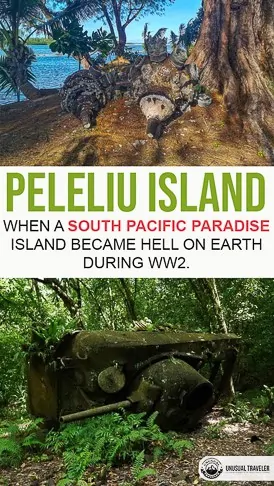

rusty
Friday 30th of June 2023
Very well done article. The entire read was both fascinating and informative. Thank you for the detailed information along with the 'bonus' of great pictures matching the narrative.
Birk
Tuesday 29th of December 2020
This was a fascinating article, with great detail! Happy to have found your blog. Many thanks from Texas, USA!